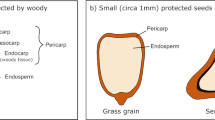Abstract
The dietary habits of the early hominids Australopithecus and Paranthropus have long been debated. Robinson1 argued that the two species differed in the proportions of meat and vegetables consumed. More recently it has been suggested2,3 that Paranthropus, with its presumably larger body size, simply pro-cessed greater amounts of the same foods eaten by Australopithecus to maintain 'functional equivalence'. Microscopic dental wear patterns are related to the dietary habits of extant mammals, and quantification of these patterns is useful in distinguishing among primates with different diets4–8. Nevertheless, few attempts have been made to use microwear in the reconstruction of early hominid diets3,9–11, and only very recently has the quantification of such data been initiated12,13. While microwear fabrics can be reduced to individual elements (for example, scratches and pits), there is some disagreement over exactly how they should be defined and measured5,6,12. Fourier transforms have been applied successfully in the study of a variety of physical and biological patterns14–16, and recently they have been used to characterize and distinguish different tooth wear patterns more objectively17. Here we report the first combined use of image processing and other quantitative techniques to analyse the dental microwear of early hominids. Our results suggest that Paranthropus ate substantially more hard food items than Australopithecus
This is a preview of subscription content, access via your institution
Access options
Subscribe to this journal
Receive 51 print issues and online access
$199.00 per year
only $3.90 per issue
Buy this article
- Purchase on Springer Link
- Instant access to full article PDF
Prices may be subject to local taxes which are calculated during checkout
Similar content being viewed by others
References
Robinson, J. T. Evolution 8, 324–334 (1954).
Pilbeam, D. R. & Gould, S. J. Science 186, 892–901 (1974).
Walker, A. C. Phil. Trans. R. Soc. B 292, 57–64 (1981).
Walker, A. C., Hoeck, H. N. & Perez, L. Science 201, 808–810 (1978).
Gordon, K. D. Am. J. phys. Anthrop. 59, 195–215 (1982).
Teaford, M. F. & Walker, A. C. Am. J. phys. Anthrop. 64, 191–200 (1984).
Teaford, M. F. Am. J. phys. Anthrop. 66, 363–370 (1985).
Teaford, M. F. in Primate Ecology and Conservation (eds Else, J. G. & Lee, P. C.) 63–66 (Cambridge University Press, Cambridge, 1986).
Grine, F. E. Proc. Electron Microsc. Soc. Sthn Afr. 7, 157–158 (1977).
Grine, F. E. S. Afr. J. Scl 77, 203–230 (1981).
Walker, A. C. in Fossils in the Making (eds Behrensmeyer, A. K. & Hill, A. P.) 182–196 (Univ. Chicago Press, Chicago, 1980).
Grine, F. E. J. hum. Evol. 15, 783–822 (1986).
Grine, F. E. Scanning Microsc. 1, 647–656 (1987).
Davis, J. C. in Data Processing in Biology and Geology (ed. Cutbill, J. L.) 69–87 (Academic, New York, 1969).
Andrews, H. C. Computer Techniques in Image Processing (Academic, New York, 1970).
Oxnard, C. E. & Yang, H. C. L. J. Zool 46, 127–167 (1981).
Kay, R. F. Scanning Microsc. 1, 657–662 (1987).
Kay, R. F. & Hiiemae, K. M. Am. J. phys. Anthrop. 40, 227–256 (1974).
Gordon, K. D. Scanning Microsc. 2, 1139–1147 (1988).
Frank, J., Shimkin, B. & Dowse, H. Ultramicroscopy 6, 343–358 (1981).
Goodman, J. W. Introduction to Fourier Optics (McGraw-Hill, San Francisco, 1968).
Sokal, R. R. & Rohlf, J. F. J. Biometry: the Principles and Practice of Statistics in Biological Research Second edition (Freeman, New York, 1981).
Mardia, K. V. Statistics of Directional Data (Academic, New York, 1972).
Kinzey, W. G. Anat. Rec. 218, 72a (1987).
Chalmers, N. R. Folia primat. 8, 247–262 (1968).
Rodman, P. S. in Primate Ecology (ed. Clutton-Brock, T. H.) 383–413 (Academic, New York, 1977).
Izawa, K. & Mizuno, A. Primates 18, 773–792 (1977).
Hladkik, C. M. in Primate Ecology (ed. Clutton–Brock, T. H.) 481–501 (Academic, New York, 1977).
Wrangham, R. W. in Primate Ecology (ed. Clutton-Brock, T. H.) 503–538 (Academic, New York, 1977).
Author information
Authors and Affiliations
Rights and permissions
About this article
Cite this article
Grine, F., Kay, R. Early hominid diets from quantitative image analysis of dental microwear. Nature 333, 765–768 (1988). https://doi.org/10.1038/333765a0
Received:
Accepted:
Issue Date:
DOI: https://doi.org/10.1038/333765a0
This article is cited by
-
Dental indicators of ancient dietary patterns: dental analysis in archaeology
British Dental Journal (2014)
-
Behavioral, Ecological, and Evolutionary Aspects of Meat-Eating by Sumatran Orangutans (Pongo abelii)
International Journal of Primatology (2012)
-
Mechanical Properties of Plant Underground Storage Organs and Implications for Dietary Models of Early Hominins
Evolutionary Biology (2008)
-
Dental microwear in relation to changes in the direction of mastication during the evolution of Myodonta (Rodentia, Mammalia)
Naturwissenschaften (2006)
Comments
By submitting a comment you agree to abide by our Terms and Community Guidelines. If you find something abusive or that does not comply with our terms or guidelines please flag it as inappropriate.



